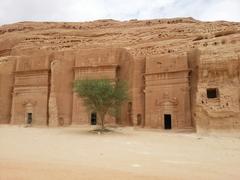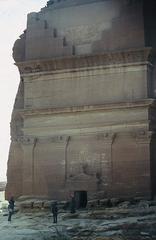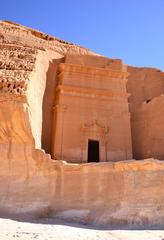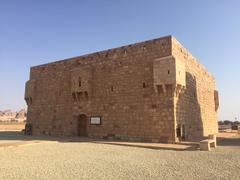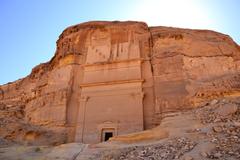Islamic University of Madinah Visiting Hours, Tickets, and Travel Guide
Date: 14/06/2025
Introduction to the Islamic University of Madinah (IUM) and Its Significance
Located in the sacred city of Madinah, Saudi Arabia, the Islamic University of Madinah (IUM) has stood as a prominent institution of Islamic learning and cultural heritage since its establishment by Royal Decree in 1961. Founded during the reign of King Saud bin Abdulaziz, IUM was envisioned as a center for promoting Islamic education globally, offering a blend of traditional Islamic sciences and modern academic fields. Welcoming students from over 170 countries, the university embodies its mission to serve the worldwide Muslim community, with only 20% of seats reserved for Saudi nationals (sdgsuniversities.org; visitalmadinah.com).
Positioned approximately 15 kilometers from the Prophet’s Mosque (Al-Masjid an-Nabawi), IUM’s location enriches the spiritual environment for both students and visitors. As a male-only academic institution, it offers a variety of undergraduate and postgraduate programs, integrating Islamic studies with disciplines such as engineering and natural sciences. This approach fosters an environment of academic innovation and community engagement (saudiuniversities.org; studyabroadaide.com).
For those planning a visit, it’s important to note that regular public visiting hours are not maintained; access is generally granted via prior permission, guided tours, or special events. Visitors should adhere to the university’s modest dress code, cultural etiquette, and gender-specific access restrictions. Exploring nearby historical landmarks such as the Prophet’s Mosque, Quba Mosque, and Mount Uhud further enhances the cultural and spiritual experience in Madinah (gokitetours.com; iu.edu.sa).
This guide presents an in-depth overview of IUM’s history, visitor information, cultural norms, and nearby attractions, offering essential resources for a respectful and enriching journey.
Contents Overview
- Introduction to IUM
- Historical Background and Global Impact
- Founding and Early Development
- Mission, Vision, and Academic Growth
- Visiting IUM: Practical Information
- Visitor Access and Hours
- Guided Tours and Campus Experience
- Travel Tips and Accessibility
- Nearby Attractions and Cultural Sites
- Frequently Asked Questions (FAQ)
- Global Contributions and Academic Excellence
- Visual and Multimedia Resources
- Plan Your Visit and Stay Connected
Historical Background and Global Impact
Founding and Early Development
The Islamic University of Madinah was established by Royal Decree No. 11 on 25 Rabi’ al-Awwal 1381 AH (1961 CE), under King Saud bin Abdulaziz. A select group of renowned scholars, including Sheikh Muhammad bin Nasser Al-Aboudi, formed the university’s foundational faculty. Notably, IUM was structured to serve the international Muslim community, reserving only a minority of seats for Saudi citizens (sdgsuniversities.org; visitalmadinah.com).
Mission, Vision, and Academic Growth
IUM’s mission is to be a global beacon of Islamic knowledge, merging traditional religious sciences with contemporary academic disciplines. The university has expanded to encompass faculties in areas such as engineering, science, and humanities, and offers a wide range of undergraduate and postgraduate programs exclusively for male students. This growth reflects IUM’s ongoing commitment to innovation, research, and outreach (saudiuniversities.org; studyabroadaide.com).
Visiting the Islamic University of Madinah
Visitor Access and Hours
Public access to IUM is limited; there are no regular visiting hours for tourists. Entry is typically granted for academic purposes, special events, or guided tours, and must be arranged in advance by contacting the university administration or through official tourism channels. There is no standard entry fee, though certain events or tours may have associated costs.
Guided Tours and Campus Experience
When available, guided tours offer insights into IUM’s historical significance, academic contributions, and serene campus environment. The university’s proximity to Al-Masjid an-Nabawi allows visitors to experience both educational and spiritual aspects during their stay in Madinah.
Travel Tips and Accessibility
- Location: Situated in northern Madinah, about 15 km from the Prophet’s Mosque and 20 km from Prince Mohammad bin Abdulaziz International Airport. Taxis and ride-hailing apps like Uber and Careem are the most convenient transport options.
- Dress Code: Modest attire is mandatory. Men should wear long trousers and sleeved shirts; women are strongly recommended to wear an abaya and headscarf.
- Photography: Always request permission before taking photos, especially in sensitive areas.
- Accessibility: The campus is equipped for visitors with disabilities, but advance notice is recommended for special arrangements.
Campus Etiquette and Cultural Norms
- Greetings: The customary greeting is “As-salamu alaykum” (peace be upon you).
- Conduct: Visitors should maintain respectful behavior, avoid loud conversation, and refrain from public displays of affection.
- Gender Segregation: Strictly observed in all academic and many public spaces. Female visitors may require special arrangements and accompaniment.
- Prayer Times: Facilities may close during the five daily prayers; visitors should remain respectful during these periods.
- Language: Arabic is the primary language, though English is widely spoken in academic and administrative settings.
Facilities and Visitor Services
- Campus Features: Modern lecture halls, libraries, cafeterias (serving halal food), and prayer halls.
- Accessibility: Wheelchair access and gender-segregated restrooms are available.
- Health and Security: On-site clinic and 24-hour security for visitors’ safety.
Nearby Attractions and Cultural Sites
While visiting the university, explore Madinah’s prominent landmarks:
- Al-Masjid an-Nabawi (The Prophet’s Mosque): A major pilgrimage site.
- Quba Mosque: The first mosque in Islamic history.
- Mount Uhud: Historic site of the Battle of Uhud.
- Al-Madinah Museum: Offers rich insights into the city’s Islamic heritage.
These sites, located within a short drive from IUM, offer a well-rounded spiritual and cultural experience.
Frequently Asked Questions (FAQ)
Q: Are there official visiting hours for the Islamic University of Madinah?
A: No, visits require advance arrangements and are typically limited to academic or official purposes.
Q: Is there an entry fee to visit IUM?
A: No standard entry fee; specific tours or events may have charges.
Q: Can non-Muslims visit the campus?
A: Generally, non-Muslim visitors are not permitted unless they are part of an official delegation or have special authorization.
Q: What is the dress code for visitors?
A: Modest, conservative clothing is required. Men must wear long trousers and sleeved shirts; women should wear an abaya and headscarf.
Q: How can I get to the university from the airport?
A: Taxis and ride-hailing services provide direct access, with a typical journey time of 20–30 minutes.
Global Contributions and Academic Excellence
IUM’s alumni have assumed leadership roles in religious, academic, and community contexts worldwide, influencing Islamic thought and scholarship. The university is a participant in Saudi Arabia’s Sustainable Development Goals Universities Initiative, contributing to research that bridges traditional Islamic and modern scientific disciplines (sdgsuniversities.org; opportunitiespedia.com).
Visual and Multimedia Resources
Access high-quality images, virtual tours, and video documentaries through the university’s official website and trusted tourism portals to preview IUM’s campus and surrounding areas. These resources are invaluable for prospective visitors planning their trip.
Plan Your Visit and Stay Connected
For up-to-date visitor information, tour arrangements, and interactive maps, download the Audiala app and consult official sources. Follow IUM and local tourism channels for announcements, cultural insights, and guidance on making your visit to Madinah memorable.
The Prophet’s Mosque (Masjid al-Nabawi): Key Information for Visitors
Overview
Masjid al-Nabawi is one of Islam’s holiest sites, renowned for its spiritual significance and historical legacy. Built by the Prophet Muhammad and expanded over the centuries, the mosque is distinguished by the Green Dome and its role as a center for worship and learning.
Visiting Hours and Entry
The mosque is open 24 hours daily. Access to special areas like the Rawdah is regulated, particularly during prayers or religious occasions. Entry is free; guided tours are available through authorized agencies for a fee.
Guidelines for Visitors
- Dress Code: Modest attire is required; women must wear an abaya and cover their hair.
- Photography: Permitted in most public areas, but should be discreet.
- Accessibility: Facilities for visitors with disabilities are provided.
- Transportation: Easily accessible from IUM and the airport via taxi or public transport.
Nearby Historical Sites
- Quba Mosque
- Mount Uhud
- Al-Madinah Museum
Additional Resources
Visitor Information and Cultural Etiquette: Summary and Final Tips
Visiting the Islamic University of Madinah is an enriching opportunity to experience a world-class institution at the heart of Islamic scholarship. By planning in advance, respecting university policies, and observing local customs, visitors gain a deeper appreciation of both the academic and spiritual dimensions of Madinah.
Take advantage of official resources, guided tours, and mobile apps like Audiala for real-time updates and tips. The proximity to Madinah’s historical landmarks ensures a rewarding journey that combines educational engagement with spiritual enrichment (sdgsuniversities.org; visitalmadinah.com; iu.edu.sa).
Sources and Further Reading
- sdgsuniversities.org
- visitalmadinah.com
- saudiuniversities.org
- studyabroadaide.com
- iu.edu.sa
- gokitetours.com

